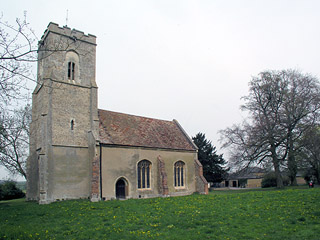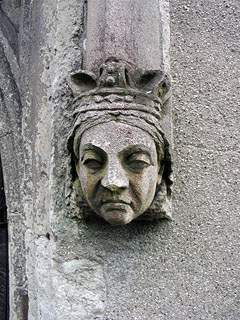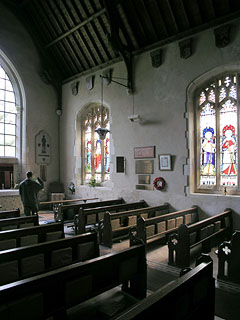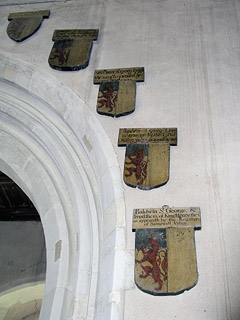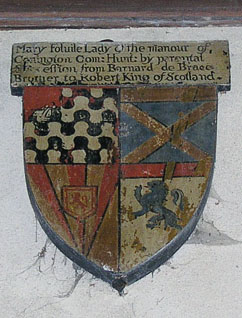St George's sits on the edge of Hatley Park, the ancient seat of the St George family. Pevsner says that the church is 'just the right distance from the house' - whatever that means. Well, even if the stately pile itself is now tastefully obscured by beech trees, the family are omnipresent once we get inside the church.
But I mustn't run ahead of myself. St George is set in a lovely churchyard, open to the road with lots of mature trees. The church is a rather peculiar shape, because it has lost its east end. Both Pevsner and the RCHM record a Victorian chancel, but in 1966 it was torn down. The chancel arch was part-filled in, and the upper half turned into a very plain east window. It makes St George seem rather taller than it is long.
The tower is quite lofty in any case. It dates from the turn of the 15th century, and was probably the work of the same mason that built the towers nearby at Barton, Caldecote, Coton and Knapwell. The upper parts were remodelled in 1625. We found the church locked, but keys were available just across the road.
Coming inside, the St George familial presence asserts itself vigorously. Running in a continuous line around the top of the walls and over the tower arch are a set of 28 painted shields, showing the arms of the local St George family over the ages and also various of their connections. They are divided into two groups. There are fifteen squarish shields which appear from their contents to have been made for a Sir Henry St George in about 1627.
The other thirteen, which are more pointed, are later and appear have been executed at various times in the late 17th century. Some of the shields have been repainted: the RCHM notes that on two shields the Cotton arms (of Landwade and then Madingley) obscure earlier paintings of the Argentine family: a palpable demonstration of shifting patterns in noble alliances.
Country churches - particularly those on the edge of gentry properties - are often places where the local family displays its importance and permanence. I've not seen it done this way before, though: political antiquarianism at its most interesting.
From a slightly earlier time, two brasses have been rescued from the chancel. They are now set in the wall to the south of the east window. The top one is Sir Baldwin St George, who died in 1425 (I suppose his shield must be around somewhere). He's lost part of his sword, but the rest of him is quite well-preserved. The second brass has fared much worse, and save for the fact that it was a woman, I couldn't make out anything.
Aside from the shields and the brasses, there's not very much left here from before the 19th century. The modern hammerbeam roof is quite nice, and comes complete with waifish angels. The fittings are generally very run of the mill, but I liked the lectern. It has a vaguely arts-and-crafts feel: a tripod with lots of swirly brass, tiny gothick arches and little glass gems set here and there. The glass in the side windows is awful Victorian stuff. I daresay they were quite nice when they were put in, but they have faded very badly; the saints are now just a load of lurid purple and orange and dirty brown blobs.
The new east window is rather stark and utilitarian, but at least it lets in some light: this must have been a very dark church before 1966.
St George left me with a peculiar feeling. It's almost as though the St Georges poured their identity into the church, and had to keep it locked up in the dark to stop it from fading. In the process, they completely took over the building: whether or not Hatley St George was a vibrant medieval village, no echoes of that community survive here to reach us.
So complete was the family's conquest of this church that it even took their name: I wonder if this church originally had a different dedication, only for later generations to forget it and call it the St George church, and eventually assume that it was always the church of St George.
Are any of the St Georges still alive? I doubt it - the line probably died out many years ago. Poor truncated St George is left here to preserve their shadows: an English Ozymandias in a desert of green fields.
UPDATE: As it happens, they still are - in late 2007 I had an e-mail from Benjamin St George, who was very good humoured about my gloomy prognosis for his family. He wrote: as much as I like the Shelleyan reference to Ozymandias ... the family line is still alive and kicking. It may have altered slightly and possesses a different Baronetcy but at least it remains.
St George is kept locked, but keyholders are clearly marked.
